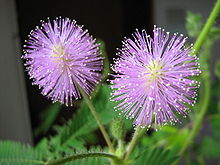Mimosa
| Mimosa | |
|---|---|
 |
|
| Mimosa pudica flower heads | |
| Scientific classification | |
| Kingdom: | Plantae |
| (unranked): | Angiosperms |
| (unranked): | Eudicots |
| (unranked): | Rosids |
| Order: | Fabales |
| Family: | Fabaceae |
| Subfamily: | Mimosoideae |
| Tribe: | Mimoseae |
| Genus: |
Mimosa L. |
| Species | |
|
About 400 species, see text |
|
| Synonyms | |
|
|
About 400 species, see text
Mimosa is a genus of about 400 species of herbs and shrubs, in the subfamily Mimosoideae of the legume family Fabaceae. The generic name is derived from the Greek word μιμος (mimos), an "actor" or "mime," and the feminine suffix -osa, "resembling", suggesting its 'sensitive leaves' which seem to 'mimic conscious life'.
Two species in the genus are especially notable. One is Mimosa pudica, because of the way it folds its leaves when touched or exposed to heat. It is native to southern Central and South America but is widely cultivated elsewhere for its curiosity value, both as a houseplant in temperate areas, and outdoors in the tropics. Outdoor cultivation has led to weedy invasion in some areas, notably Hawaii. The other is Mimosa tenuiflora, which is best known for its use in shamanic ayahuasca brews due to the psychedelic drug dimethyltryptamine found in its root bark.
The taxonomy of the genus Mimosa has had a torturous history, having gone through periods of splitting and lumping, ultimately accumulating over 3,000 names, many of which have either been synonymized under other species or transferred to other genera. In part due to these changing circumscriptions, the name "Mimosa" has also been applied to several other related species with similar pinnate or bipinnate leaves, but are now classified in other genera. The most common examples of this are Albizia julibrissin (silk tree) and Acacia dealbata (wattle).
...
Wikipedia
